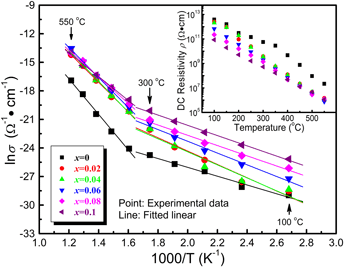Article contents
Effect of (K0.5Ce0.5) complex on the electrical properties of lead-free Bi4Ti2.86W0.14O12 high-temperature piezoelectric ceramics
Published online by Cambridge University Press: 02 October 2020
Abstract

Potassium and cerium co-doped Bi4Ti2.86W0.14O12 ceramics with a formula of (K0.5Ce0.5)xBi4−xTi2.86W0.14O12 (abbreviated as KC100x-BITW, x = 0, 0.02, 0.04, 0.06, 0.08, 0.1) were prepared by a conventional solid-state reaction method. The effect of (K0.5Ce0.5) complex doping amount on the structure, dielectric, and piezoelectric properties of the KC100x-BITW ceramics was investigated. X-ray diffraction results indicated that the KC100x-BITW ceramics are Aurivillius-type phase with the bismuth layer structure. (K0.5Ce0.5) complex addition first increases and then decreases the grain size which can be observed by scanning electron microscopy. With the increase of (K0.5Ce0.5) complex doping amount, the Curie temperature (TC) was slightly decreased from 632 to 608 oC. The dielectric and piezoelectric properties were optimized in KC100x-BITW ceramics with x = 0.08 as follows: d33 = 24 pC/N, kp = 8.2%, Qm = 6766, εr = 135 (@100 kHz), tanδ = 0.28% (@100 kHz), Tc = 611 oC, and resistivity ρ = 2.9 × 106 Ω cm at 500 oC, indicating that the KC100x-BITW ceramics are suitable for high-temperature piezoelectric sensing applications.
- Type
- Invited Paper
- Information
- Copyright
- Copyright © The Author(s), 2020. Published by Cambridge University Press on behalf of Materials Research Society
References
- 7
- Cited by





